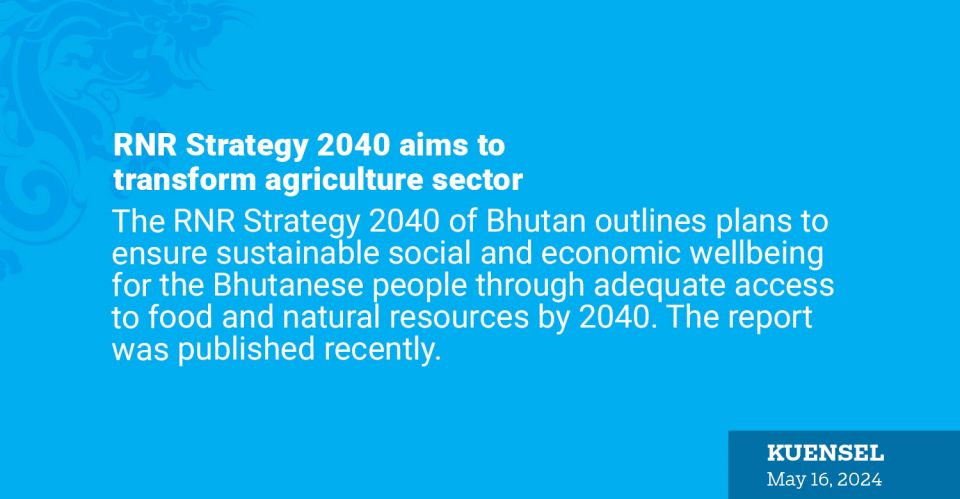
The RNR Strategy 2040 of Bhutan outlines plans to ensure sustainable social and economic wellbeing for the Bhutanese people through adequate access to food and natural resources by 2040. The report was published recently.
The agriculture sector in Bhutan struggles because of a lack of adequate investment in resources, technological innovation, internal processes, and uncoordinated projects among agencies.
The strategy highlights the key challenges in the renewable natural resources (RNR) sector, which is one of the five important drivers of economic development in terms of its potential to ensure self-reliance.
The contribution of the RNR, the primary sector, to GDP, steadily declined from 38 percent in 1992 to 14.67 percent in 2022.
However, in 2022, the manufacturing (secondary) and service (tertiary) sectors made substantial contributions to GDP with growth rates of 5.6 percent and 6.62 percent, respectively.
By 2034, the agriculture and livestock sector will have to feed about 837,288 people, which calls for timely intervention to the challenges.
Challenges
According to the Food and Nutrition Security Policy of Bhutan 2023, the absence of a comprehensive human resource plan, including development and deployment, has led to a decline in public investment, resulting in weak monitoring and evaluation.
Technological challenges, such as the cost of production and the adaptability of improved technologies in the country, exacerbate the issue.
Similarly, weak institutional linkages and coordination have posed challenges and duplicated work. “For example, every agency emphasises smallholder farming projects, neglecting the larger projects,” the strategy states.
The key challenges for the production and consumption in agriculture at the grassroots level includes labour shortages, feminisation of agriculture, an ageing farming population, human-wildlife conflicts, and a changing climate.
Looking ahead
Sustainable agriculture in Bhutan is an important factor for socioeconomic development and growth.
As Bhutan addresses its lapses, the approach is an investment in the sustainable utilisation of high-value resources for food security and livelihood.
Bhutan is approximately 70 percent food self-sufficient. There is high demand for Bhutanese products with the potential for capturing international markets given serious marketing.
Research shows that about 24 percent of the agricultural land is mechanised, while the remaining 76 percent is still cultivated using traditional methods.
Although agriculture’s contribution to GDP is declining, it provides employment and livelihood to more than 54 percent of the population. Additionally, it meets more than 70 percent of domestic food requirement and raw materials for agro-based industries.
To transform the sector, the RNR Strategy 2040 proposes eleven strategies. They are enhancing production and quality of RNR commodities, enhancing the contribution of the RNR sector to the national economy, accelerating agri-business development and expansion, developing enabling policies for the RNR sector, strengthening research, innovation and dissemination, instituting efficient RNR service delivery, enhancing production efficiency of RNR commodities, promoting research and innovation, diversifying sustainable financing for RNR sector development, mainstreamingsustainable management of natural resources, and enhancing and promoting resilience to the impacts of climate change.
Implementing these strategies will require Nu 7,545 million by 2025, Nu 7,855 million by 2030, and Nu 6,241 million by 2040, together totalling Nu 21,641 million.
The first Five-year Plan between 1961 and 1966 coincided with the Green Revolution of the 1960s, which provided access to high-yielding crop varieties and production technologies.
According to the Department of Agriculture reports, model farms, seed farms, research stations, and extension work were started. Furthermore, the export of agricultural commodities, such as apples, mandarin, potatoes, cardamom, ginger, betelnut, and vegetables in the region is being implemented.
To boost the export, the report suggests investment in improving quality standards including volume requirements, consistency, and packaging of produce.
Bhutan is projected to be a high-income country by 2034 with a GDP of USD 10 billion, up from USD 2.3 billion in 2021.












